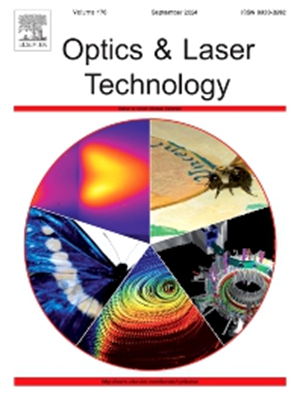Tailoring microstructure and mechanical properties of IN738LC fabricated by laser powder bed fusion through processing parameter optimization
IF 4.6
2区 物理与天体物理
Q1 OPTICS
引用次数: 0
Abstract
IN738LC has been widely used in hot-end components owing to its excellent high-temperature performance, while it has still suffered from metallurgical defects during laser powder bed fusion (LPBF) due to its high crack sensitivity. This study investigated forming behavior, microstructure evolution and mechanical property of LPBF-processed IN738LC samples at different parameters (laser power of 150–300 W, scanning speed of 500–1500 mm/s). The result indicated that the decrease in energy density caused the width and depth of the melt pool to decrease and eventually broke into droplets, leading to an increase in porosity. As the scanning speed increases, the microstructure changes from irregular columnar/cellular dendrites to all distributed as columnar dendrites, exhibiting epitaxial growth. An optimal process window was finally obtained at a laser power of 200 W and a scanning speed of 1000 mm/s, which achieved excellent forming quality (the porosity of 0.01 %) and mechanical properties (microhardness of 445.5 HV, ultimate tensile strength of 1335 MPa and elongation of 19.3 %). This study provides process basis for subsequent studies of IN738LC fabricated by LPBF.
IN738LC 因其优异的高温性能已被广泛应用于热端部件,但由于其裂纹敏感性高,在激光粉末床熔化(LPBF)过程中仍存在冶金缺陷。本研究考察了不同参数(激光功率为 150-300 W,扫描速度为 500-1500 mm/s)下 LPBF 加工 IN738LC 样品的成形行为、微观结构演变和机械性能。结果表明,能量密度的降低导致熔池的宽度和深度减小,并最终破碎成液滴,从而导致孔隙率增加。随着扫描速度的增加,微观结构从不规则的柱状/细胞状树枝状突起转变为全部分布为柱状树枝状突起,表现出外延生长。最终,在激光功率为 200 W、扫描速度为 1000 mm/s 的条件下,获得了最佳工艺窗口,实现了优异的成型质量(孔隙率为 0.01 %)和机械性能(显微硬度为 445.5 HV、极限拉伸强度为 1335 MPa、伸长率为 19.3 %)。这项研究为 LPBF 制造 IN738LC 的后续研究提供了工艺基础。
本文章由计算机程序翻译,如有差异,请以英文原文为准。
求助全文
约1分钟内获得全文
求助全文
来源期刊
CiteScore
8.50
自引率
10.00%
发文量
1060
审稿时长
3.4 months
期刊介绍:
Optics & Laser Technology aims to provide a vehicle for the publication of a broad range of high quality research and review papers in those fields of scientific and engineering research appertaining to the development and application of the technology of optics and lasers. Papers describing original work in these areas are submitted to rigorous refereeing prior to acceptance for publication.
The scope of Optics & Laser Technology encompasses, but is not restricted to, the following areas:
•development in all types of lasers
•developments in optoelectronic devices and photonics
•developments in new photonics and optical concepts
•developments in conventional optics, optical instruments and components
•techniques of optical metrology, including interferometry and optical fibre sensors
•LIDAR and other non-contact optical measurement techniques, including optical methods in heat and fluid flow
•applications of lasers to materials processing, optical NDT display (including holography) and optical communication
•research and development in the field of laser safety including studies of hazards resulting from the applications of lasers (laser safety, hazards of laser fume)
•developments in optical computing and optical information processing
•developments in new optical materials
•developments in new optical characterization methods and techniques
•developments in quantum optics
•developments in light assisted micro and nanofabrication methods and techniques
•developments in nanophotonics and biophotonics
•developments in imaging processing and systems

 求助内容:
求助内容: 应助结果提醒方式:
应助结果提醒方式:


